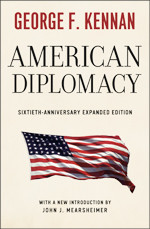The Realist Who Preached Jeremiads
George F. Kennan holds an iconic standing among twentieth century American thinkers on international relations. The diplomat turned public intellectual played a key role in crafting policy during the pivotal early years of the Cold War by articulating the threat posed by the Soviet Union and framing the policy of containment as a response. His knowledge of Russia and Europe gave American leaders a language for discussing the challenge even when they took positions Kennan later deplored. A decades-long academic career following his retirement from the Foreign Service enabled him to reflect upon his practical experience of diplomacy. Kennan’s writing on Russian and European history, along with commentary on America’s role in the world as the Cold War passed through its endgame, conferred an authority. He became a realist voice on international affairs until his death in 2005 at age 101. A Pulitzer Prize winning biography by John Lewis Gaddis only enhanced Kennan’s posthumous reputation. Like many icons, however, Kennan has been more often invoked than understood. An expanded sixtieth anniversary edition of American Diplomacy provides a welcome opportunity to revisit his perspective.
American Diplomacy originated in the Charles Walgren lectures Kennan gave at the University of Chicago in 1951 after he left government for the Institute of Advanced Studies at Princeton. The published version became a standard text for courses in diplomatic history and international relations that went through several editions with new material added. Kennan expressed surprise to an audience at Grinnell College in 1984 that it remained in print. A new anniversary edition includes the Grinnell Lectures and two major Kennan essays for Foreign Affairs—“The Sources of Soviet Conduct” (July 1947) and “America and the Russian Future” (April 1951)—along with a critical introduction by the noted political scientist John Mearsheimer. What began as an occasional piece took on a life of its own. So why did it resonate beyond the author’s expectations?
The central question Kennan poses in his thematic overview suggests the answer. Given that the United States had enjoyed a sense of security in the 1890s unmatched since Rome, how and why had the situation reversed so sharply fifty years later? American preponderance in a political system where great power rivalry had given way to ideological conflict between superpowers left the United States feeling less secure. Applying practical diplomatic experience might illuminate the country’s predicament and its underlying causes. American Diplomacy thus sought to “identify the relationship between challenge and response in American diplomacy” since the 1890s and then consider what weakness of analysis or concept led to failure when the response fell short.
Kennan sketches the story in a conversational tone with the Spanish American War as an opening vignette. Public outrage fanned by the press and Congressional pressure drove Washington’s response. Kennan argues that President McKinley could have won a favorable settlement had he secured authorization to negotiate at his own discretion. The Spanish offered major concessions to avert war, but the American government never seriously considered a peaceful solution and a Congressional resolution on April 20, 1898 gave Spain an ultimatum it could not honorably accept. War soon followed.
Although public debate drove American responses as the crisis escalated, strategy and operations during the war itself were determined beyond the public eye. Kennan describes the process as “a very able and quiet intrigue by a few strategically placed persons in Washington” that received subsequent approbation in an atmosphere of war hysteria fueled by military success. Bringing Spain’s empire beyond Cuba under American rule, marked “a turning point in the whole concept of the American political system.” Where significant territorial acquisitions previously had been sparsely populated regions within continental North America intended for eventual statehood, new overseas dominions would remain subordinate colonies. The debate over empire came only after the spoils of war forced a decision. Policy followed events rather any logical decision process or reflection upon larger consequences for the national interest. The eventual outcome left even the proponents of empire disillusioned.
John Hay’s Open Door Note countered the exclusive foreign spheres of influence in China and showed a similarly haphazard approach while underlining a moralistic tone in American diplomacy. The initiative took up a policy the British had abandoned with more attention to banking credit in Anglo-American relations than the actual situation in China. Quiet lobbying by an English administrator of the Chinese customs service brought the matter before Hay’s advisor on Far Eastern Affairs and McKinley approved a paper they drafted. Hay accordingly dispatched notes to the leading foreign powers requesting their commitment to sustaining an open door for regular trade in China.
The notes put other governments in an awkward sport. They responded with predictable evasiveness that gave the public impression the United States had stopped foreigners on the verge of an improper action. Nothing substantive came out of the exchange, which Hay declared a success, but it fostered what Kennan deplores as a moralistic-legalistic approach that wrongly imposed an Anglo-Saxon concept of individual law to international relations. Demanding adherence to high minded principles brought little advantage in dealing with other powers no matter the plaudits it won American officials at home. Indeed, Kennan laments that American diplomacy focused more on the domestic audience than its ostensible targets abroad.
The European balance of power, as Kennan notes repeatedly, long guaranteed American security by denying any one country control over Europe’s resources. World War I, however, shattered that equilibrium and gradually forced the United States into taking a part in European affairs it had long avoided. Woodrow Wilson described the war and its origins as points outside American concern. Kennan argues that prudent foresight would have justified earlier intervention to secure a favorable balance before the war and prevent escalation that only made problems worse. Stressing the horrific toll the conflict took upon Europe, he describes how it shattered societies, overthrew institutions, and made realistic compromise impossible. Hatreds congealed to limit the ability of governments to moderate their aims to secure peace. Spared the worst of the prolonged struggle, the United States declared war under circumstances that ensured it would fight to a bitter end.
Democracies, as Kennan writes, fight in anger to punish those “rash enough and hostile enough to provoke it.” The junction of an impractical idealism that dismissed the past with contempt and war hysteria brought a peace settlement that could not last. Besides the power vacuum left by the collapse of Austria-Hungary and Imperial Russia, the terms imposed upon Germany were, as a French historian remarked, too mild for the suffering they contained. A peace settlement that make renewed war all too likely “had the tragedies of the future written into it as by the devil’s own hand.” A reactive approach guided by domestic concerns kept the United States from prudently attending to its interests and thereby mitigating those consequences.
Western democracies went to war again in 1939 under very inauspicious circumstances as the weaker party in a defensive struggle with Nazi Germany. Defeating Germany required help from the Soviet Union that came at a steep cost. Even after the United States entered the war, the West could secure only part of its aims and even that much in cooperation with a totalitarian power. The nature of Adolf Hitler’s regime made compromise impossible, so the war had to be fought to the end. Kennan questions whether the mistakes of World War II lay more in the conceptual failure to appreciate the limits to what war can achieve than operational or strategic errors. Different choices might have made a difference on the margins by placing the Western allies in Central Europe sooner and shifting the demarcation line between East and West. A division of Europe, however, was unavoidable. Americans expected more than the circumstances of World War II allowed, making eventual disappointment with its outcome all too likely. Kennan argues throughout that a more realistic view of that predicament would have made the United States more united after 1945 and less prone to blame what followed on stupidity or bad faith.
While taking pains to note successes alongside failures, Kennan points out “a very significant gap between challenge and response” in American foreign policy that presented grave risks during the early Cold War. The main problem involves what he calls the legalistic-moralistic approach. An outlook among American statesmen derive from the legal profession from which they largely have been drawn heightens an error that frames issues in the wrong terms and establishes a language for diplomacy that hinders effective communication with governments operating under different assumptions. The legalistic-moralistic approach fits the American tendency to pitch diplomacy to a domestic audience by feeding the desire to appear more wise and noble than the case warrants. While Kennan accepts that popular reactions may not be erratic and undependable over the long term, he insists that popular opinion or what passes for it among Washington insiders leads too easily to a dangerous emotionalism that sharpens the anger with which democracies fight. Emotionalism also makes the concept of total victory a dangerously alluring shortcut that obscures what war can and cannot accomplish.
Kennan argues for a greater humility in national outlook. His approach to Soviet-American relations takes a realist perspective grounded in history and culture that marks an alternative to what he criticizes in the lectures. The sources of Soviet conduct lie in a combination of Russia’s historical experience and Communist ideology with the need to keep the regime in power. History and geopolitics point to continuities between Russia’s tsarist and Soviet rulers that delineate friction points with the West. Marxism fuels confrontation by positing an irrepressible conflict between communist and capitalist societies ending with the destruction of the latter.
Kennan shrewdly notes that conflict helps Soviets preserve control over the own people with a constant state of war justifying repression and therefore urges a policy of containing the Soviets within their own sphere where the system may well collapse under the weight of its own contradictions. Containment, however, requires a long-term steady commitment different from countering the aggression of an individual leader which raises problems for the West. Kennan’s view of a more acceptable Russia eschews a liberal democracy remade in America’s image for the more modest goal of a country dispensing with “the paranoiac suspiciousness” of Soviet Communism and defending its own interests without assuming they can only be furthered at the expense of others. Russia would also give up internal totalitarian controls over its people and satellite regimes along its border. Such reforms could only be secured through diplomatic pressure and military victory offers no shortcut.
How does Kennan’s assessment stand after sixty years? Mearsheimer argues in his introduction that American leaders took a more realist view of the balance of power in Europe and Asia than Kennan credits. Legalism held less sway than assessments—correct or not—of the national interest. If the political system, which remained largely constant, led American policy astray, why was the United States not equally in trouble throughout the period? Such challenges, as Mearsheimer writes, do not take away from the book’s insights, but they compel a closer, more critical look to test their applicability. Kennan makes important points about geopolitics and the workings of diplomacy, but Averell Harriman rightly described him as a man who understood Russia better than the United States.
Alongside the realist observer of international politics stands a romantic itching to preach a jeremiad about his own country’s departure from virtue and discipline. It takes a thorough grounding in the underlying history to catch where Kennan shifts from one perspective to the other. While Kennan deftly illuminates a number of turning points that set key precedents for American foreign policy, he read too many of his own preoccupations into the story and overlooked factors outside them. He hits the mark, however, on the general need for more humility in facing complex situations in very different societies. The principle of first doing no harm applies to diplomacy no less than medicine.


